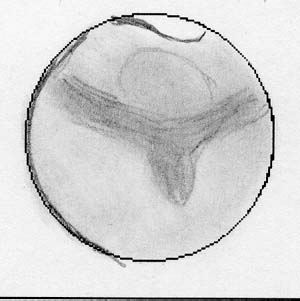
Sketched August 9, 2003 from my back deck 2:00 a.m. pacific DST (daylight savings time) or 09:00 UT. Poor but usable observing conditions, from 1:45 a.m. to 2:45 a.m. The wind shook the small refractor some and the views were like observing pepples under a flowing stream. There were moments of slightly better seeing, so the sketch shows a little more detail than the previous night.
| Date: 08/9/03 Lat 37N, Long 122W, elev. 200 feet | Sketch Time (UT): 9:00, (local time): 2:00 a.m. DST |
| Central Meridian: 270° | Filters: none |
| Instrument: 4-inch (105mm) f/6 Astro-Physics Traveler Apo refractor. | Distance from earth 0.40 AU, 60m km, 37m miles |
| Magnification: (6mm) 252x (10mm) 151x Zeiss Abbe Orthos combined with a 2.4x AP Barcon Barlow | Transp. 2/6, Seeing 3/10, Antoniadi (I-V): IV - V |
| Apparent Size: 23.7" | Magnitude: -2.6 |
Mars, in this sketch is reversed N/S. South is shown at the top of the image. The angular dark feature below Hellas is Syrtis Major. In between, is the geologic feature which reminds me of a pair of speedo swim trunks. Mare Cimmerium with Mare Tyrrhenum flank (pun intended) Syrtis Major. The terminator is where daylight ends and evening begins, and the phase, nearing opposition is 97.5% illuminated right now. The terminator is on the left and the planet is rotating left to right. In my sketches the planet rotates martian east (left) to west (right) to match most other images and sketches. Look for features rotating from left to right in the drawings from night to night.
Details about Mars: Diameter 23.7 arc seconds (Jupiter is about 30 -50 arc seconds in diameter depending on its distance from earth). Central Meridian 270 - the imaginary line passing through the planetary poles of rotation and bisecting the planetary disk, and is used to determine the longitude during an observing session.

White Oaks Home | Sketches Index | Mars 2003 Index | Back | Next